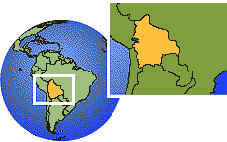
Bolivia

Bolivia, republic in central South America, bounded on the north and east by Brazil, on the southeast by Paraguay, on the south by Argentina, and on the west by Chile and Peru. Bolivia and Paraguay are the only South American countries without direct access to the sea. The maximum length of Bolivia from north to south is about 1530 km (about 950 mi); its maximum breadth is about 1450 km (about 900 mi). Its area is 1,098,581 sq km (about 424,165 sq mi), making it fifth in size (after Brazil, Argentina, Peru, and Colombia) of South American countries. The constitutional capital of Bolivia is Sucre (population, 1992, 130,952); La Paz (711,036) is the largest city and administrative capital.
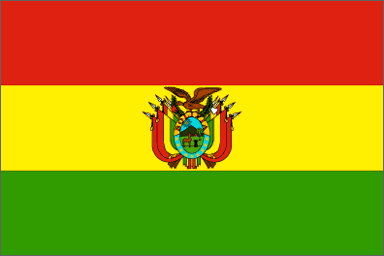
Land and Resources
The principal physical feature of Bolivia is the Andes mountain range, which extends generally north to south across the western part of the country. The Andes form two ranges in Bolivia, the western range (Cordillera Occidental), which runs along the Chilean border, and the eastern range (Cordillera Oriental), the main range, which crosses the west central part of Bolivia. The Cordillera Oriental contains some of the highest Andean peaks, notably Ancohuma (6550 m/21,489 ft), Illampu (6485 m/21,276 ft), and Illimani (6462 m/21,201 ft).
Physiographic Regions
Bolivia is divided into three distinct regions: the Altiplano, or plateau region; the Yungas, a series of forested and well-watered valleys embracing the eastern mountain slopes and valleys; and the llanos, or the Amazon-Chaco lowlands. The Altiplano is about 800 km (about 500 mi) long and about 130 km (about 80 mi) wide and lies between the Cordillera Occidental and the Cordillera Oriental. In the northern part of the Altiplano, where the bulk of the population and industry of Bolivia is found, is Lake Titicaca, the highest large, navigable lake in the world. The southern part of the plateau is arid.
Stretching east and northeast from the mountains are the great Amazonian plains (llanos) containing large grassy tracts and, along the rivers, dense tropical forests. Much of this region becomes swampland during the wet season (December through February); large areas, however, lie above the flood line and are rich grazing lands. In the southeast, separated from the Amazonian plains by the Chiquitos highlands (about 1070 m/about 3500 ft), are the dry, semitropical plains of the Chaco (see Gran Chaco).
Rivers
In the northern and northeastern valleys and plains, the drainage system consists of the Beni River and its main affluent, the Madre de Diós River; the Guaporé River, which forms part of the boundary with Brazil; and the Mamoré River. The Pilcomayo River, the chief river of southeastern Bolivia, flows through the Chaco to feed the Paraguay River, thence eventually draining into the Río de la Plata. The Desaguadero River, outlet for Lake Titicaca, feeds Lake Poopó to the southeast.
Climate
Although situated entirely within the tropics, Bolivia has, as a result of its varied elevation, a wide range of climate. In the higher regions the climate is cold and dry. In the lower-lying regions the climate is warmer. The mean annual temperatures range from about 8° C (about 47° F) in the Altiplano to about 26° C (about 79° F) in the eastern lowlands.

Bolivian farming methods are much the same as they were a hundred years ago. Farm production accounts for more than 20 percent of Bolivia’s gross domestic product, and nearly half of the country’s workers are employed in the industry.
Kevin Healy
Natural Resources
Deposits of metallic ores are large and varied. Mineral resources include tin, lead, silver, copper, antimony, zinc, sulfur, bismuth, gold, and tungsten. Salt, petroleum, and natural gas are also found. The soil of certain regions, notably the valleys east of Santa Cruz (the Valle), is extremely fertile. The annual output of hydroelectric plants in the late 1980s amounted to 1.1 billion kilowatt-hours, 74 percent of Bolivia's total.
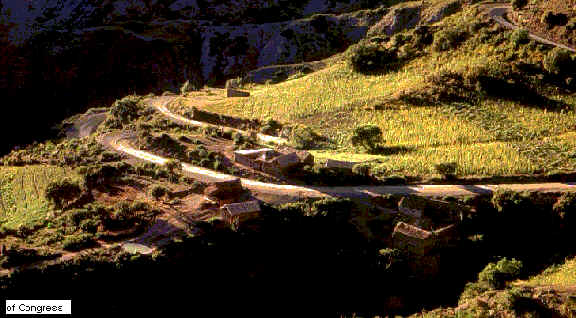
Few residents live in the Yungas region of Bolivia, which is northeast of the Andean highlands on the eastern slopes of the Andes Mountains. It is one of four major land regions in the country.
Kevin Healy
Plants and Animals
Because of the wide variations in elevation, plant and animal species of nearly every climatic zone are found in Bolivia. A coarse grass, called ichu, grows on the largely barren high plateau in the west. Para rubber trees, more than 2000 species of hardwood trees, and vanilla, sarsaparilla, and saffron plants are common in the tropical forests of the east. The llama, found chiefly on the Altiplano, is an efficient beast of burden. Alpaca and vicuña also inhabit the plateau, and monkeys, puma, jaguar, armadillo, and a variety of reptiles, birds, and insects are found predominantly in the tropical Amazon Basin.
Population
The population of Bolivia (1995 estimate) is about 8,074,000. Population density was about 7 persons per sq km (about 19 per sq mi), one of the lowest in South America. Roughly 55 percent of all the people are Native American, and about 30 percent are mestizo, of mixed blood. The remaining inhabitants are white, mainly of Spanish descent. About 55 percent of the people live in rural areas.
The official languages of Bolivia are Spanish and two Native South American languages, Quechua and Aymara; of those the Native American languages are more commonly spoken. Roman Catholicism is the religion of the great majority of the population.
Political Divisions
The republic is divided into nine major political divisions, called departments: Santa Cruz, El Beni, Tarija, Potosí, La Paz, Chuquisaca, Pando, Cochabamba, and Oruro.
Principal Cities
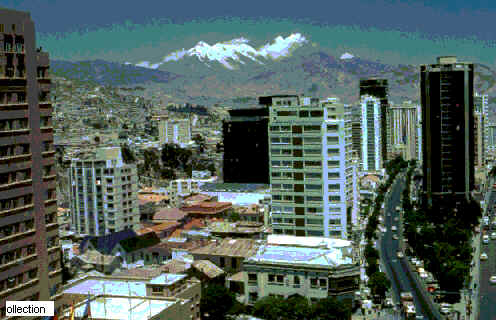
The city of La Paz, the administrative capital of Bolivia, is a manufacturing and export center. La Paz is located in the Andes Mountains. In this view of the city, the mountain called Illimani can be seen in the background.
Daniel I. Komer/DDB Stock Photography
La Paz is Bolivia's largest city and is also its administrative capital (population, 1992 estimate; 1,115,403). Other important cities are Santa Cruz (694,616), a major trade center; Cochabamba (404,102), in a fertile farming region; Oruro (183,194), in the mining district; Sucre (130,952), the country's constitutional capital; and Potosí (112,291), also in a mineral-producing region.
Education
Primary education is nominally free and compulsory for children between the ages of 6 and 14, but the public schools, although increasing in number, do not meet the needs of Bolivia, which has an illiteracy rate of almost 25 percent.
In the late 1980s about 888,200 pupils attended primary schools, about 211,500 attended secondary schools, and about 97,200 were enrolled in institutions of higher education.
Bolivia has ten universities: in Sucre, La Paz (two), Cochabamba, Llallagua, Oruro, Potosí, Santa Cruz, Tarija, and Trinidad. Saint Francis Xavier University (1624), in Sucre, is one of the oldest in the Americas. The University of San Andrés (1830), in La Paz, is the largest university in Bolivia, with a student enrollment of about 37,000.
Culture
In dress, language, architecture, and lifestyle, the large Native American population follows the ways of its ancestors with a mixture of modified Spanish traditions. Clothing is colorful and suited to life in high altitudes. Holidays and religious festivals are celebrated by dancing and festivities. The Spanish-speaking population, which is largely European in ancestry, and is educated and better off economically, has adopted some of the Native American customs but generally follows Western traditions. See Latin American Literature; Latin American Music.
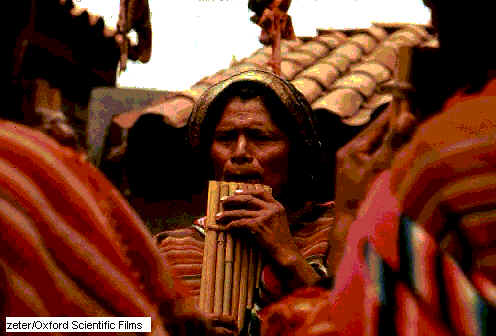
Largely inhabited by Quechua- and Aymara-speaking peoples, the highland region of the Andes is primarily centered in Bolivia, Peru, and Ecuador. Home to some of the oldest musical forms in the Americas, the region features ensembles that accompany dancers in religious and secular ceremonies dating from the Inca period. Instrumentation in these ensembles includes panpipes made of cane or bone, conch shell trumpets, flutes, and drums. This example, called "Sicuriada," is a traditional melody from Bolivia.
Kevin Healy/"Sicuriada" from Music of the Andes and Argentina (Cat.# Music of the World T-112) (p)1988 Music of the World, Ltd. All rights reserved.
Economy
Although many of the largest mining operations were nationalized during the 1950s, successive Bolivian governments have encouraged private industrial development and actively sought foreign investment capital. Budget figures for 1995 showed revenues and expenditures balanced at about $3.75 billion. The state airline, Lloyd Aéreo Boliviano, was sold to private interests in 1993. In 1995 Bolivia began implementing a unique privatization program in which additional state-owned companies would not be sold outright; instead, half of the company's shares and management control would be awarded to the highest private bidder. The remaining shares would be divided among Bolivia's adult population and held in retirement accounts that would form a new private pension system. Despite these efforts to deflect charges that Bolivia was "selling out" its resources to foreigners, the privatization efforts drew sustained criticism and prompted serious labor strife. In June 1995 Bolivia sold a controlling interest in the state electricity company to three U.S. firms. In 1996 the state railroad was privatized and the state petroleum company was put up for sale. Bolivia's estimated gross domestic product (GDP) in 1994 was $5.5 billion.
Agriculture, Fishing, and Forestry
Agriculture is extremely important to the Bolivian economy, employing nearly half the labor force. Farming, fishing, and forestry accounted for about 21 percent of the annual gross domestic product (GDP) in 1995. Bolivia's agriculture suffers from antiquated farming methods, uneven population distribution, and inadequate transportation. Although now self-sufficient in the production of sugar, rice, and meat, Bolivia must still import certain foodstuffs. The chief Bolivian crops are soybeans, sugar, chestnuts, potatoes, cassava, bananas, maize, rice, plantains, and citrus fruits. Fishing is a relatively unimportant industry in landlocked Bolivia. The lack of transportation facilities has prevented large-scale exploitation of wealth in the Bolivian forests, which cover more than half the country's area, mostly in the east.
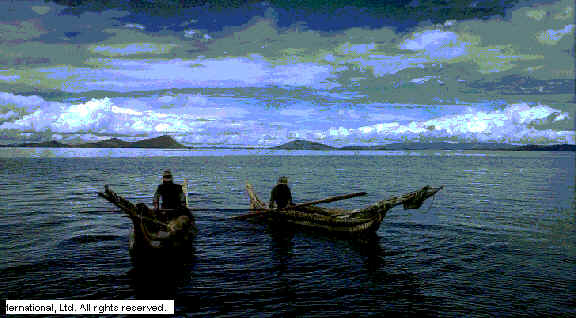
Lake Titicaca in northern Bolivia is the largest lake in South America and the highest navigable lake in the world. Native Americans living in this treeless region make canoes out of tule or other bulrushes lashed together. The region around the lake contains architectural remains of early Native American civilizations; some of these remains date to before the Incan civilization.
Ed Drews/Photo Researchers, Inc.
Mining, Manufacture, and Trade
Mining, a major industry in Bolivia, was hampered in the late 1980s by weak prices on world markets. Bolivia has long been one of the world's leading producers of tin. In 1952 its three major tin-mining operations were nationalized under the Corporación Minera de Bolivia (COMIBOL). Most of the tin mines are located in the vicinity of Oruro; the annual output of tin concentrates in the early 1990s was about 16,000 metric tons. Also mined are zinc, lead, antimony, tungsten, and silver. Petroleum and natural gas production increased in importance in the 1960s and early 1970s; by the early 1990s Bolivia was self-sufficient in petroleum and was exporting significant amounts of natural gas to Argentina.
Manufacturing enterprises are on a small scale; industry accounted for 17 percent of GDP in 1994 and employed less than 10 percent of the labor force. The manufacture of cement and the refining of sugar and flour are Bolivia's major industries. Smaller industries include leather working, tobacco processing, and the manufacture of chemicals, paper, furniture, glass, explosives, and matches. More than two-thirds of all manufacturing is in La Paz, which is also the center of domestic trade.
Although Bolivia has long been dependent on mineral exports, declining tin prices and increased petroleum and natural gas production changed the nature of the country's economy in the 1980s. By the early 1990s, natural gas accounted for 27 percent of export earnings while tin provided just 12 percent. Zinc, silver, gold, lead, and antimony are other important mineral exports. Soybeans, wood, and sugar are also exported. Bolivia's imports consist mainly of machinery, motor vehicles, electric equipment, and manufactured goods. In 1994 annual imports totaled about $1.2 billion, and exports earned about $1.1 billion.
The United States, Argentina, Japan, and Brazil are Bolivia's principal trading partners. Bolivia also trades with its Andean Group partners, which include Colombia, Ecuador, Peru, and Venezuela. Founded in 1979, the group works toward common policies on energy, tariff reduction, industrial and agricultural development, political cooperation, improved internal and international trade, and the creation of a common market. Bolivia is also a member of the Latin American Integration Association (LAIA), an organization with many of the same goals as the Andean Group, but on a wider scale. In 1996 Bolivia joined the Southern Cone Common Market (known by its Spanish acronym, MERCOSUR), a trade group dedicated to lowering tariffs and removing other trade barriers among its member nations. MERCOSUR—which also includes Argentina, Brazil, Paraguay, and Uruguay—covered a market of more than 190 million people in 1995, making it the world's fourth largest free trade group.
Currency and Banking
The basic unit of currency is the boliviano, equivalent to 1 million old Bolivian pesos (4.72 bolivianos equal U.S.$1; 1995). The Banco Central de Bolivia is the sole bank of issue. Several state-owned development banks provide investment credits to small mining and agricultural operations. Foreign and domestic private financial institutions also operate in the country.
Transportation and Communications
Bolivia had 3684 km (about 2289 mi) of railroad tracks in 1995. Railroads connect the landlocked country to ports on both the Atlantic and Pacific oceans. The principal line connects La Paz with the free port of Antofagasta, Chile. Bolivia also has free port privileges in the maritime facilities of Argentina, Brazil, and Paraguay.
About 42,800 km (about 26,600 mi) of roads exist in Bolivia; only a few are hard-surfaced, and many are passable only in the dry season. In 1996 Bolivia announced plans to build a $100 million two-lane paved highway between the highland city of La Paz and the lowland tropical communities of eastern Bolivia, the country's most productive agricultural region. The project will transform a one-lane dirt road that dates back to Inca times and vastly improve the only direct link between the capital and the Amazonian lowlands.
The national airline, Lloyd Aéreo Boliviano, provides regular air service between the major Bolivian cities, with other Latin American countries, and with the United States. About 10,000 km (about 6214 mi) of rivers are navigable by light-draft vessels.
About 4,600,000 radio sets, 755,000 television receivers, and 144,000 telephones were in use in the late 1980s. Bolivia has 17 daily newspapers.
Labor
Bolivia's labor force exceeded 1.7 million in the early 1990s. Nearly the entire nonfarm labor force is organized, most of it in unions belonging to the Central Obrera Boliviana (COB), the central labor federation. Peasant unions were established after the 1952 revolution.
Government
Bolivia is a republic governed under a constitution passed in 1967 and since amended.
Executive
Executive power is vested in a president and vice president, elected for terms of 4 years by direct popular vote of married people over the age of 18 and single people over 21. Neither the president nor the vice president can be reelected to an immediate succeeding term. The president appoints the cabinet. Among other presidential powers is the right to rule by decree.
Legislature
The Bolivian congress is bicameral, composed of a senate of 27 members (3 from each department) and a chamber of deputies of 130 members. All are elected for four-year terms.
Political Parties
The principal political parties are the Movement of the Revolutionary Left (MIR), the Nationalist Revolutionary Movement (MNR), and Nationalist Democratic Action Party (ADN).
Local Government
Bolivia is divided into nine departments administered by prefects appointed by the president. Each department is divided into provinces, administered by subprefects appointed by the president. Important cities and towns have popularly elected councils.
Judiciary and Defense
Justice is administered by the Supreme Court, which is composed of 12 members, elected by the congress to ten-year terms, and by district and local courts. Military training is universal and compulsory, but in practice only a small percentage of those registered for service are drafted. In the late 1980s the combined strength of the armed forces was 28,000.
Health and Welfare
Health conditions are poor in Bolivia. In the mid-1980s the country had 1 physician for every 1600 inhabitants. The infant mortality rate is among the highest in South America; malaria, dysentery, and tuberculosis are common, and there was a serious outbreak of yellow fever in the late 1980s. Medical services and hospitals are particularly inadequate in rural areas. Bolivia has a comprehensive social insurance plan, but it covers less than half the working population.
History
The territory of Bolivia, a part of the ancient empire of the Incas, was conquered in 1538 by the Spanish conquistador Hernando Pizarro, younger brother of the Spanish explorer Francisco Pizarro, who subdued Peru, heart of the Inca Empire. Within the next 40 years, Spanish settlements were formed at Chuquisaca (present-day Sucre), Potosí, La Paz, and Cochabamba; the Spanish opened numerous silver mines in which the Native American population was compelled to labor. For some 200 years the area, known as the Audiencia of Charcas, was one of the most prosperous and populous centers in the Spanish colonies; Potosí may have been the largest city in the western hemisphere. The area began to decline in the 18th century, and by the end of it, the mining industry was in a state of stagnation.
Revolts in 1809 led to the Wars of Independence. Bolivia declared its independence of Spain on August 6, 1825 and took the name of Bolivia on August 11. A constitution drafted by the South American revolutionary leader Simón Bolívar, after whom the country is named, was adopted by a congress at Chuquisaca in 1826. It vested supreme authority in a president chosen for life.
From the beginning of its national existence, Bolivia was plunged into a state of nearly chronic revolution and civil war. The first president, General Antonio José de Sucre, was expelled from the country after holding office for only two years. During the next half century, interludes of political tranquility were brief and infrequent. Between 1836 and 1839 Bolivia was in a confederation with Peru, but a Chilean invasion brought an effective end to it, increasing the turbulence. Short wars and disputes with both Peru and Chile followed.
Boundary Disputes
By treaties made in 1866 and 1874 regarding the disputed Atacama Desert, famed for its rich nitrate fields, the 24th parallel of south latitude was adopted as the Chile-Bolivia boundary line in that region. In addition, various customs and mining concessions in Bolivian Atacama were granted to Chile. Disputes arose between the two countries over the latter provisions, and in 1879 Chile seized the Bolivian port of Antofagasta. In the resulting struggle, called the War of the Pacific, Bolivia and its ally Peru were defeated by Chile. Bolivia was stripped of its one seacoast possession, becoming a landlocked country. A treaty ratified in December 1904 recognized the perpetual dominion of Chile over the disputed territory but granted Bolivia free access to the sea. A dispute with Brazil concerning the possession of the Acre region was settled in 1903, by the cession of about 180,000 sq km (about 70,000 sq mi) to Brazil in return for a money indemnity and small territorial compensations elsewhere.
The Bolivian government subsequently became involved in boundary disputes with Argentina, Peru, and Paraguay. A peaceful solution of the dispute with Argentina was reached in 1925. Peru and Bolivia settled disputes over the peninsula of Copacabana by appointing, in the 1930s, a joint commission to decide the border.
The Paraguay-Bolivia boundary dispute arose over the Chaco Boreal, a low region lying north of the Pilcomayo River and west of the Paraguay River and extending to the undisputed boundary of Bolivia. Both Bolivia and Paraguay claimed the entire territory. In July 1932 an undeclared war broke out (see Chaco War). A peace treaty was signed in July 1938.
In 1945 Bolivia became a founding member of the United Nations. Three years later it joined with other nations of the Americas in founding the Organization of American States. Bolivia has requested that both organizations consider its petition to regain a seaport on the Pacific Coast. Chile, opposing Bolivia's ambitions, declared Arica a free port in 1953 and granted Bolivia special customs and warehousing facilities.
Political Instability
The period after 1930 was marked by further internal strife. In that year, President Hernando Siles, who had governed for two years without convening the national legislature, was overthrown in a revolution. Daniel Salamanca, elected president in 1931, was overthrown in 1934 by a clique under Vice President Tejada Sorzano, who in turn was ousted by a military junta led by Colonel David Toro. Toro was largely successful in his attempts to extricate the country from the desperate conditions resulting from the world depression and the Chaco conflict with Paraguay. He made enemies, however, in influential quarters, and in 1937 he was ousted by a group led by Lieutenant Colonel Germán Busch, chief of the general staff.
In 1938, during Busch's second term as president, a new constitution was adopted. Busch abolished the new constitution in April 1939, however, and set up a totalitarian state. Four months later he was found dead of a bullet wound, an alleged suicide. General Carlos Quintanilla, who then assumed the presidency, restored the 1938 constitution and stated that the army would exercise control until new elections could be held.
In 1940 General Enrique Peñaranda was elected president, and on April 7, 1943, during World War II, he declared war against the Axis powers. In December 1943, Peñaranda was ousted in a coup staged by the National Revolutionary Movement (Movimiento Nacionalista Revolucionario, or MNR), a reformist party that included pro-Axis sympathizers. The new government, headed by Lieutenant Colonel Gualberto Villarroel, was compelled by economic pressures to maintain good relations with the Allied powers. Villarroel headed a totalitarian regime until he was overthrown and killed in July 1946.
The government continually faced opposition from both left and right, and after the discovery of a Communist plot early in 1950, the Communist Party was outlawed.
The Regime of Paz Estenssoro
In May 1951, the exiled MNR leader Víctor Paz Estenssoro won nearly half the presidential election vote. Because no candidate had a clear majority of the vote, election of a president from among the three leading candidates fell to Congress. In order to prevent the election of Paz, the incumbent president, Harriaque Urriolagoitia, placed the government under the control of a military junta and resigned. General Hugo Ballivián was appointed president, but in April 1952 his government was overthrown by the MNR, and Paz Estenssoro returned from exile to assume the presidency. The Bolivian government embarked on a pro-labor, anti-Communist program, the key features of which were the nationalization of tin mines, the redistribution of land from expropriated estates, and the diversification of the economy. Throughout the 1950s and into the 1960s the Bolivian economy suffered from a steady drop in world tin prices and from inflation. The tin mines proved consistently unprofitable; government efforts to reduce the size of the force employed in the mines and to restrain wage increases met with resistance from the leftist unions. The Bolivian constitution prevented the reelection of Paz Estenssoro in 1956, but Vice President Hernán Siles Zuazo won election as the MNR candidate; the result of this election was a continuity of policy. Paz Estenssoro was reelected in 1960 and in the following year pressed for the adoption of a new constitution that extended the economic authority of the government and permitted the reelection of an incumbent president. Paz Estenssoro was reelected in 1964, but many of his earlier supporters left him, charging that the MNR was less reformist and more oppressive than it purported to be. Also, the government policies proved generally ineffective in meeting the existing economic problems. Paz Estenssoro was overthrown in November in the aftermath of an uprising by miners, and his government was succeeded by a military junta headed by his former vice president, Lieutenant General René Barrientos Ortuño.
Rule by the Army
In the ensuing two years, the military government succeeded in instituting reforms in tin mining operations, including reopening the industry to private and foreign investment. Barrientos, who was elected to the presidency as a civilian in July 1966, was forced, however, to depend heavily on armed force to put down Communist-led guerrilla movements concentrated in the mountainous mining regions. The Bolivian army reportedly smashed the rebel forces in October 1967, in a pitched battle near the village of Vallegrande. Che Guevara, aide to Cuban Premier Fidel Castro, was captured in that encounter and executed shortly afterward. Barrientos was killed in the crash of a helicopter in April 1969 and a series of short-lived governments followed, most led by military men. General Juan José Torres Gonzáles was overthrown by Colonel Hugo Banzer Suárez in August 1971. The Banzer regime moved from a relatively moderate position to full military control in 1974. Banzer stepped down in 1978, pending restoration of civilian government, but elections in 1979 and 1980 were each followed by renewed military intervention. By 1982 the country's earnings from tin production had declined, and foreign debt continued to rise. The illegal export of cocaine was thriving, and the U.S. was pressing Bolivia to take decisive steps against the drug traffic.
In October 1982 Hernán Siles Zuazo was installed as president; he faced several cabinet crises and was unable to resolve problems brought on by international banks. After an inconclusive popular election, Congress chose Víctor Paz Estenssoro as president in August 1985. His government's attempts to cut down coca production and the sale of cocaine, aided by a contingent of U.S. troops from July to November 1986, were only partially successful and very unpopular. Jaime Paz Zamora, who finished third in the popular election of May 1989, became president of Bolivia in August after winning a congressional runoff. The next presidential elections, held in June 1993, were won by mining entrepreneur Gonzalo Sánchez de Lozada. Sánchez de Lozada's vice president, Víctor Hugo Cárdenas, was the first Native American to hold such a high office in Bolivia. Sánchez de Lozada worked to implement a number of reforms intended to give more economic and political power to Bolivia's Native American majority. He oversaw a redistribution of the federal budget that boosted money for roads, schools, and water projects in largely native rural areas. The government also legalized native organizations and the practice of folk medicine, all of which had previously been outlawed. In addition, the government allowed bilingual education in Spanish and Native American dialects in schools that previously had been prohibited from teaching any language other than Spanish.
As the government continued to work to promote a free market in Bolivia, it moved toward privatizing state oil holdings in 1995 and 1996. Bolivian labor activists responded by staging a series of strikes and protests calling for higher wages and the end of plans to privatize the oil industry. More than three weeks of civil disturbances in April 1995 by thousands of union workers and state employees prompted the government to arrest over 300 labor leaders and suspend constitutional rights so that the government could hold people without a trial. When the protest campaign resumed in 1996, the government deployed soldiers and police to protect refineries and pipeline facilities.